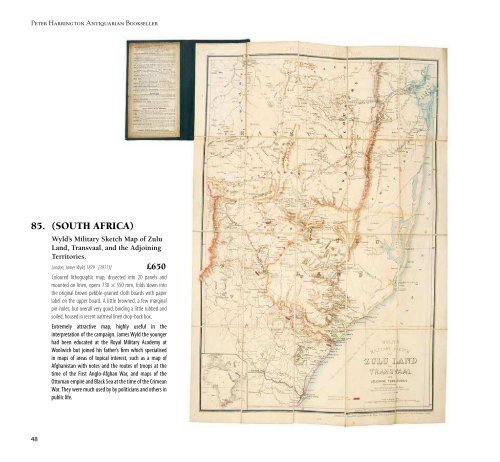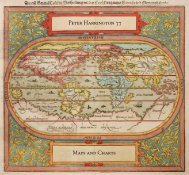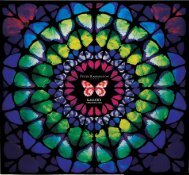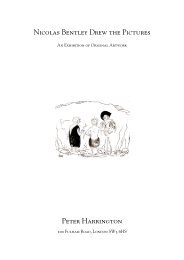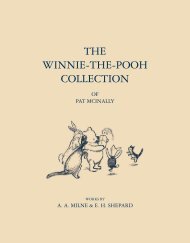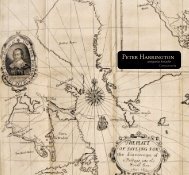antiquarian bookseller - Peter Harrington
antiquarian bookseller - Peter Harrington
antiquarian bookseller - Peter Harrington
Create successful ePaper yourself
Turn your PDF publications into a flip-book with our unique Google optimized e-Paper software.
<strong>Peter</strong> <strong>Harrington</strong> Antiquarian Bookseller Catalogue 57: Travel Section 2: Africa and the Middle East to Persia<br />
85. (SOUTH AFRICA)<br />
Wyld’s Military Sketch Map of Zulu<br />
Land, Transvaal, and the Adjoining<br />
Territories.<br />
London, James Wyld, 1879 [39113] £650<br />
Coloured lithographic map, dissected into 20 panels and<br />
mounted on linen, opens 730 × 550 mm, folds down into<br />
the original brown pebble-grained cloth boards with paper<br />
label on the upper board. A little browned, a few marginal<br />
pin-holes, but overall very good, binding a little rubbed and<br />
soiled, housed in recent oatmeal linen drop-back box.<br />
Extremely attractive map, highly useful in the<br />
interpretation of the campaign. James Wyld the younger<br />
had been educated at the Royal Military Academy at<br />
Woolwich but joined his father’s firm which specialised<br />
in maps of areas of topical interest, such as a map of<br />
Afghanistan with notes and the routes of troops at the<br />
time of the First Anglo-Afghan War, and maps of the<br />
Ottoman empire and Black Sea at the time of the Crimean<br />
War. They were much used by by politicians and others in<br />
public life.<br />
86. SPARRMAN, Anders.<br />
A Voyage to the Cape of Good Hope,<br />
towards the Antarctic Polar Circle,<br />
and Round the World: but chiefly<br />
into the Country of the Hottentots<br />
and Caffres, from the Year 1772, to<br />
1776. Translated from the Swedish<br />
Original.<br />
London, G. G. J. and J. Robinson, 1786 [18319] £2500<br />
2 volumes, 4to. (222 × 272mm). Bound in contemporary<br />
lightly sprinkled tan full calf, sympathetically rebacked,<br />
smooth spine, double gilt ruled compartments, red-brown<br />
morocco labels. Folding map and 10 engraved plates.<br />
Attractive contemporary armorial sepia-printed bookplates<br />
of Smith, motto “temperato splendeat usu”, to the front<br />
pastedowns. Some light browning, short closed tear to the<br />
map, boards a little rubbed, but overall a very good copy.<br />
Second Edition, Corrected. A botanist and disciple of<br />
Linnaeus, Sparrman’s desire to travel was stimulated by<br />
an early trip as a surgeon on a Royal Swedish East India<br />
Company ship to Canton via the Cape. Further opportunities<br />
were thwarted by his lack of funds. However, in 1771 his<br />
friend Capt. Ekeberg of the RSEIC obtained for him the<br />
position of tutor to the children of M. Kerst, sub-Governor<br />
of the Cape. Once settled there his intention to undertake<br />
an expedition to the interior was interrupted by the arrival<br />
at the Cape of Cook on his second voyage, whom Sparrman<br />
accompanied as assistant to the naturalist Johann Georg<br />
Forster, experiences which he recounts but briefly here.<br />
On his return in 1775 he had accrued sufficient funds to<br />
finance his own expedition and “ … set out overland from<br />
the Cape … in the company of a South African named<br />
The most<br />
trustworthy<br />
account of<br />
the Cape<br />
Colony<br />
Immelman paralleling the Southern coast and visiting the<br />
regions of Swellerdam, Mossel Bay and the country to the<br />
north of Port Elizabeth. His furthest east was the Great<br />
Fish River” (Howgego). Theal describes this as the 18th<br />
century’s “most trustworthy account of the Cape Colony<br />
and the various races of people residing in it.” He made<br />
the first study of the Bushmen and relates many incidents<br />
illustrating the hospitality of the Dutch farmers and their<br />
“dense ignorance” of matters outside their own country.<br />
Also alludes to the “cruelty of the treatment of the slaves<br />
by the lower classes of the colonists” (Mendelssohn). On<br />
his return to Sweden he was elected to the Academy of<br />
Sciences and appointed as conservator of the museum.<br />
Sparrman later returned to Africa as part of an expedition<br />
to the West Coast searching for suitable locations for<br />
Swedish settlement.<br />
Howgego S154; Mendelssohn II, pp.414–5; NMM I, 211.


